Spanish Sunshine in Shanagarry with John Wilson
On a lovely spring morning, John Wilson brought some Spanish sunshine to the 12-week certificate students here at the cookery school in Shanagarry. John Wilson, one of Ireland best known wine writers, and wine correspondent to The Irish Times, introduced the students to the wine regions and wines of Spain, while also incorporating Spanish food, heritage and culture into the morning’s masterclass on Wines of Spain.
John gave a tutored tasting of the following wines:
Louro de Bolo 2015 Valdeorras, Rafael Palacios
La Iña Fino Lustau, Jerez
La Malkerida 2014 Utiel-Requena
Flor de Brezo Gregory Perez, Bierzo
La Bruja de Rozas 2015, Viños de Madrid, Sierra de Gredos, Commando G.
Rioja Reserva 2012, Marques de Murrieta
Ribera del Duero Cosecha 2014, Emilio Moro

John Wilson is the Irish Times wine correspondent, John Wilson http://www.irishtimes.com/life-and-style/food-and-drink/drink/the-white-wines-of-galicia-1.2814683 and has 20 years of practical experience in the wine trade under his belt. He is author of ‘Wilson on Wine 2015, 2016 and 2017 edition. His other wine writing including editing ‘The Wine Guide’, Ireland’s best ever selling wine book. Most of all, as he says himself, he likes a glass of decent wine. You can follow John on twitter at @wilsononwine and on his blog www.wilsononwine.ie

The Wines of Spain masterclass by John Wilson to the 12 week certificate cookery students at Ballymaloe Cookery School was fantastic – the students really appreciated it and they felt like they were in Spain itself, learning all about Spanish wines and regions and also the food, places and people.
The Spanish wines showed very well under the East Cork sunshine!

Slice of Ham and a Glass of Wine…
I told the students the week before that they were in for a treat at the following wine class… “a slice of ham and glass of wineâ€, knowing just how good it was going to be, but wanting the students to discover this for themselves. @ColmMcCan
We were delighted to welcome John Wilson, wine writer, The Irish Times to the Cookery School on Wednesday 25th October 2016, for a talk & tutored tasting on Wines of Spain.

Irish Times wine correspondent, John Wilson has 20 years of practical experience in the wine trade under his belt. He is author of ‘Wilson on Wine 2015, 2016 and his just published 2017 edition. His other wine writing including editing ‘The Wine Guide’, Ireland’s best ever selling wine book. Most of all, as he say himself, he likes a glass of decent wine. You can follow John on twitter at @wilsononwine and on his blog www.wilsononwine.ie
John was a wonderful guide, taking us on a journey through the wine regions and grape varieties of Spain, culture, heritage and of course food – especially food and wine matching.
And to back up all the theory, we had a practical too – with a line-up of wines to taste:
- RÃas Baixas 2015, Bodegas Fefiñanes
- El Bolo Godello 2015, Valdeorras, Rafael Palacios
- El Castro de Valtuillé, Bierzo Joven 2014, Bodegas Valtuillé
- Adnos Bobal 2012, Valencia, Alta Expresión
- Lopez Herederia Viña Tondonia Rioja Reserva 2004
- Matarromera Crianza 2012, Ribera del Duero
- La Iña Fino, Bodegas Lustau, Jerez
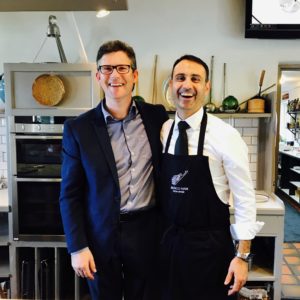
Spain truly came to East Cork with when John was joined by Mario Hiraldo Regalado, Iberico Ham master carver, who gave a masterclass talk & demo to the students. The Iberico Ham, expertly carved by Mario, paired perfectly with the Fino Sherry introduced by John. As Darina told the students, it is one of the most delicious pairings. The students could see for themselves why Iberico Ham is often described as one of the most extraordinary gourmet products in the world. ‘The Iberico black pig’s ancient breed, chemical-free diet, free range rearing in the Dehesa, a network of pasturelands dotted with holm and cork oak in South-West Spain followed by 2 years curing, resulting in what is often described as ‘the most prized meats’. This was a real treat very much appreciated by the cookery students
Over the course of his 17-year career, Mario Hiraldo Regalado has evolved into a master of all things Ibérico. In fact, his official title is Master Carver and Ham Controller. He has become an ambassador of that technique and tradition, teaching all over the world. His passion and profession have landed him squarely in the grand traditions of Spanish Jamón, with posts as Master Carver for Turismo Andaluz S.A. and D.O.P. Jamón de Huelva, respectively. You can follow Mario on twitter at @mariohiraldo
Our thanks to Counsellor Javier Moral Escudero, Embassy of Spain, and Sara and Esther and all in the Economic and Commercial Office of the Embassy of Spain in Dublin for all their help in organising this fantastic visit. @SpainFoodWineIE
What a truly delicious and memorable morning for the students!
Celebrating World Sherry Day at Ballymaloe Cookery School
We were delighted to join in with the week long celebration of Sherry for World Sherry Day (week)
We had a Sherry talk and tasting here in the school for the students on all things Sherry, We were delighted to be joined by Rafael Salazar, of Vinostito, who is orginally from Cadiz, Andalucia, so Rafeal and Colm were delighted to introduce the students to Sherry – its culture, history, tradition, food, and of course Sherry.
Some photos here to capture a day, which we all really enjoyed. More details to follow on the Sherry and tasting notes.
Some previous Sherry events at Ballymaloe are listed here



Ballymaloe Literary Festival of Food and Wine
The inaugural international Literary Festival of Food and Wine took place at Ballymaloe House, Grainstore and Cookery School over the May Bank Holiday wekend, 3 – 6 May. A magical weekend was had, with many wine & drinks events, and here are a selection of photographs and some links to write-up on the weekend. We are already looking forward to 2014 Literary Festival!
http://guides.ie/megabites/jancis-robinson-mw-ballymaloe-litfest-leslie-williams
http://www.jancisrobinson.com/tasting_articles/ta20130508.html
http://www.jancisrobinson.com/articles/a201305091.html
http://www.corkbilly.com/2013/05/the-ballymaloe-litfest-not-book-just.html

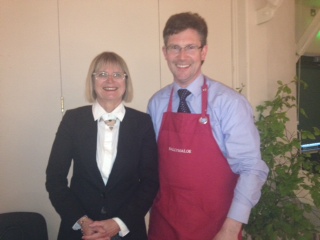



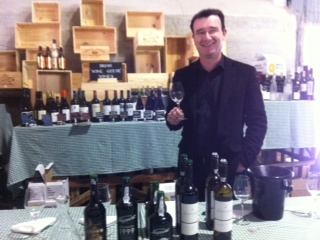

















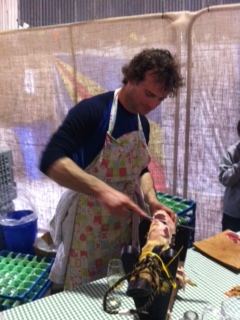

González Byass, Jerez, Spain
The famous Spanish wine company, Gonzalez Byass, established in 1835 in the Jerez region, it is still a family owned business and it is now at the 5th generation.
They produce wine in different regions of Spain: Rioja, Toledo, Jerez, Somontano, Penedes and Cava. Oscar Bayo presented a selection of wines – Cava, White, and Reds from different regions of Spain, and of course a selection of Sherry, including the range of their very special 30year old Sherries – Del Duque Amontillado, Apostoles Palo Cortado, Mathusalem Oloroso and Noe Pedro Ximenez – a stunning range and line-up of some of the most complex Sherries.

IWSC Spanish Wine Producer of the Year 2010. González Byass, Jerez, Spain
 Pictured recently in the wine cellar at Ballymaloe, in advance of the Gonzalez Byass wine event, were Joe Cronin, Ballymaloe (who celebrates 60 years working at Ballymaloe this month) and Colin Downey, Barry & Fitzwilliam Wine Merchants, who co-hosted the event with Ballymaloe.
Pictured recently in the wine cellar at Ballymaloe, in advance of the Gonzalez Byass wine event, were Joe Cronin, Ballymaloe (who celebrates 60 years working at Ballymaloe this month) and Colin Downey, Barry & Fitzwilliam Wine Merchants, who co-hosted the event with Ballymaloe.
Oscar also spoke to the students of the 12-week Cookery Course at the school, with an emphasis on Sherry and Food, in particular how well Fino goes so well with food, especially Iberico Ham
(Pictured is the Grain Store at Ballymaloe set for a previous Sherry event in Ballymaloe, earlier this year, in May,when we welcomed Cesar Saldana, Consejo Regulador, Jerez, in association with Wines of Spain and The Irish Times)
Natural Wine
With guest speakers Pascal Rossignol, of Le Caveau, Kilkenny and Dario Poddana, of Les Caves de Pyrène, London.
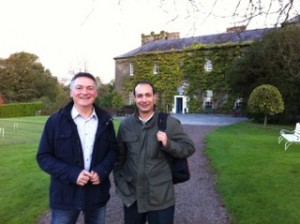
Our thanks to both Dario and Pascal – Dario came over especially from London, and his talk and tasting was very much appreciated by the students, along with regular guest wine lecturer at the school, Pascal Rossignol, who came from Kilkenny, and as always our thanks and appreciation to Pascal.
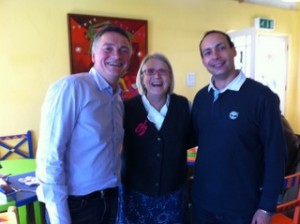
We tasted 7 Natural with the students, all of which showed very well.

ORGANIC, BIODYNAMIC AND NATURAL WINE, by Tim Wildman MW (Les Caves de Pyrène)
Wine is perceived as one of the most natural and healthy of alcoholic beverages.
Consumers might be surprised to discover that the majority of everyday wine is
produced using a wide variety of chemicals, both in the vineyard and the winery, traces
of which can end up in the final wine (ever wondered why cheap wine gives you such a
headache?). A vineyard is almost unique in that vines cannot be crop rotated, and
cannot be left to lie fallow. As a consequence the use of agrochemicals over time leads
to a build up of pathogens and a depletion of soil health. This weakens the vine,
creating a cycle of dependency on chemical treatments. As vineyards become “green
concrete†wine makers are waking up to the fact that high input farming using synthetic
herbicides, pesticides, fungicides and fertilizers is becoming unsustainable. At the same
time consumers are becoming more aware of the ingredients in the food and drink they
buy, looking for healthier, additive free options. The coming together of these two
phenomena has resulted in a number of alternatives for the thoughtful and
environmentally conscious wine consumer, but what are the difference between the
various classifications, and which, if any, has any real meaning?
ORGANIC
Organic producers will only make good wine if they also made good wine before
becoming organic. This may seem self evident, but organic certification is – at its
simplest – adhering to a list of chemicals not to add to your vineyard. Tick the list and
you can be certified organic, irrespective of the quality of what you produce. An oven
pizza may be labelled organic but its not exactly haute cuisine. Requirements for
organic certification vary widely around the world, with many countries not
“recognising†each others accreditation, so there are plenty of grey areas. To add
further confusion, in the EU organic accreditation covers only the grapes, and not what
happens in the winery. Hence you will only ever see an EU wine labelled as “made from
organically grown grapesâ€. Think of the organically grown lettuce that is treated with
chemical preservatives to keep it fresh on the supermarket shelf. Organic therefore is no
guarantee that a wine has not had chemicals used in the processing of it. There are
many superb example of high quality organic wineries, but the term should be treated
with caution unless you know the producer in question, or trust the place or person you
buy it from.
BIODYNAMIC
Biodynamics requires a much greater commitment from the grower and is often referred
to as “super-charged†organics. Rather than simply reducing chemical inputs,
biodynamics is a proactive attempt to bring life to the soil by the use of composts and
organic preparations. Biodynamic vineyards always “feel†alive and healthy. Practices
take into account the seasons as well as lunar and solar rhythms, which would not have
seemed strange to our ancestors. Rudolph Steiner founded the biodynamic movement in
the 1920s in an attempt to bridge the two worlds of modern science and what he
referred to as “peasant wisdomâ€. Some critics are sceptical of the more arcane
elements of biodynamics but often concede that the end result is better tasting wine.
This may simply be down to the old maxim that the best fertilizer is the farmers
footsteps. Some of the worlds leading wine producers are now working biodynamically
including Felton Road (New Zealand), Domaine Leflaive (Burgundy) and Zind-Humbrecht
(Alsace). For many it is a practical and sustainable farming solution, and as such you will
not always see it written on the label or used as a marketing tool. Biodynamic
certification is a sound guarantee of responsible environmental practice, the wines
should always have a clear sense of place (terroir) and quality can be exceptional.
NATURAL WINE
Natural wine is a relatively recent phenomenon, but one that is currently receiving a lot
of attention. In its simplest form, natural wine takes organic or biodynamic practices in
the vineyard as its starting point, and extends them into the winery in an attempt to
reduce the total use of chemical inputs and manipulations throughout the entire
production process. The key difference is often the low or zero use of sulphur dioxide
(SO2). Natural wine is not an accredited or legally defined term, but refers to a broad
range of desirable practices both in the vineyard and the winery. These include the use
of organic or biodynamic treatments to bring life to the soil, hand harvesting, no
chapitalization (added sugar to raise potential alcohol), no added enzymes, the use of
natural wild yeasts for fermentation, no added “flavourings†or adjustments (oak chips,
tannin powder, acidification or de-acidification), low or zero use of sulphur dioxide
through ferment and elevage, no or very light filtration and fining and finally low or zero
sulphur additions at bottling (understood to be less than 20ppm for white, 10ppm for
red).
In essence, nowt taken out and nowt put in.
There is also a recognizably “natural wine style†emerging, which for many is the chief
allure of this category. For some it is also its biggest weakness. At their best, natural
wines display lightness and purity of fruit. They have higher levels of acidity, often
combined with more restrained levels of alcohol, for reds often in the 11 to 12.5 range,
yet are fully flavour ripe. They are lean, fresh, mineral and often have little or no new
oak. As a result they can be incredibly drinkable. They can also be nutritious in the true
sense of the word, being living products, they appeal to the stomach as well as the
palate. Think Yakult or unpasturised cheese. The driving philosophy of many natural
wine makers is simply to make a wine that they can drink a lot of, which may sound
strange, even irresponsible, until you consider that many “modern†show-stopper wine
styles can impress with a sip, but are impossible to finish the bottle. Natural wine can
often be simple, but what they lack in weight or complexity they make up for in
drinkability and fun.
Like biodynamics, natural wine is a trustworthy sign of environmentally friendly vineyard
practices as well indicating the minimal use of additives and chemicals inputs in the
winery. As such it is the most “organic†of the accreditations if by organic we mean low
chemical additives. In addition natural may also signal a recognizable style of wine. This
style may not be everybody’s cup of tea, but ultimately this will depend on whether you
like your apple juice cloudy, your cheese stinky and your milk straight from the cow.
The proof of the pudding will always be in the drinking, and the best bottle on the table
is always the empty one.
The previous wine class at the cookery school, we had tasted both sulphured, and unsulphured dried apricots, with a majority of the class having a preference for the unsulphured apricots – so we were all well ready for an interesting tasting of Natural wines, which included the following:
PROSECCO DI VALDOBBIADENE, CASA COSTE PIANE
Casa Coste Piane is a tiny 6-ha, in Santo Stefano, heart of the Valdobbiadene area, owned and run by Loris Follador. For generations their wine had been sold in bulk, but since 1983 they decided to bottle the production themselves.
The organically-run vineyards lie on slopes close to the cellar. The vines are on average 60 years old (some are pre-phylloxera!!) and their roots can grow up to 30-40 metres long. This Prosecco is a gem, it is one of the few made in the champenoise method wherein the second fermentation takes place in the bottle.
Harvest is usually between the last week of September and the first week of October.
In April the wine is bottled without the addition of yeast and sugar, subsequently the indigenous yeast contained in the wine starts a second spontaneous fermentation that lasts for approximately four weeks.
After this the wine spends a further four weeks ‗sur lie‘. The process of ―disgorgement‖ is not practised, therefore the yeasts are still present in the bottle… any haziness is entirely natural.
This is very Champagne-like, with great purity and frankness; the aromas are of apple, acacia flowers with an interesting mineral twist and subtle yeastiness.
2010 MONTLOUIS AC ‘MINERALE +’, FRANTZ SAUMON
Frantz Saumon used to be a forester in both Canada and France, in 2001, after graduating from oenology school, he purchased a small three hectares property in Montlouis, which grew quickly to 5.5 ha.
Frantz set about to make true Montlouis that reflected the specific terroir of that appellation, and to this end he began converting the vineyards to organic viticulture and relying only on indigenous yeast. Most of his vineyards are planted with old vine Chenin Blanc (he likes to do everything in his vineyards by hand himself, one reason he has so little land).
The winery is an underground cellar carved into the tuffeau, the ubiquitous fossil-rich clay of the region, and all the wines are vinified in barrels (some 228l, some 400l)
Minérale+ is a natural wine, made without sulphur, wild yeast fermented, no additions and organically grown grapes. The wine delivers a lot of ripe apple and pear on the nose, with classic wet wool hints, grapey and gentle spice. Rich and full on the palate, tangy, quite mineral and ending with fresh, balancing acidity.
2010 COTE DU RHONE BLANC ‘CLOS DES GRILLONS’, NICOLAS RENAUD
Nicolas Renaud’s wines come from vineyard parcels on a variety of different soils: white sands, galets stones, yellow and redclays and marls and are exclusively classed as Côtes du Rhône and Côtes du Rhône-Villages-Signargues. He has been practising organic viticulture with dedication since 2006. In the cellar he vinifies with natural yeasts and without sulphur which is for him the only way of respecting and rediscovering terroir.
The vineyard area today comprises 15 hectares of vines most of them planted before 1960, the majority of the vines being Grenache Noir for the reds and Grenache Blanc for the white. He is also restoring the old local varieties such as Counoise and Bourboulenc and in 2011 reintroduced Picpoul Gris and Grenache Gris.
Grillons Blanc is made up of from 35 year old Grenache Blanc 70% with the balance from Bourboulenc, Clairette, Ugni Blanc 30%, a blend of four different parcels on the communes of Saze and Rochefort. After the must settles over one night there is fermentation (without temperature control) in barrels.
Honey, fennel, acacia flowers on the nose;Â The palate gradually builds in intensity and culminate with an explosion of wild mint freshness. Very lenghty and perfectly balance.
2009 GRAN CERDO TEMPRANILLO, GONZALO GONZALO GRIJALBA
Gonzalo Gonzalo was born in Logroño, Spain and grew up among the vineyards that his parents cultivated in Fuenmayor.
After studying biology in León and oenology in the university of Rioja, he dedicated himself to travelling through France and Italy where he met small vine-growers and winemakers and discovered new varieties of grape and technologies After completing his oenologist training in an industrial winery, in 2003 he abandoned everything to give birth to Orgullo, his personal oenology project.
Fiercely protective of the terroir of his family vineyards Gonzalo rejects market driven fashions, formulae, chemical treatments and conformism. Instead he has sought out his own methods with respect for the land, his vineyards, and the traditions of his forefathers. He balances this respect with formal training in the latest enological techniques and methods.
Gonzalo was profoundly influenced in his choice of viticultural methods by the fact that his father became seriously ill from years of daily exposure to high-spec chemical fertilizers and herbicides while tending their vineyards in the 1970s, when they were regarded as the panacea for all vineyard problems. It was not clear at the time that chemicals that were perfectly safe in small doses had significant harmful effects from cumulative, long term exposure. The soil itself suffered as well, losing its vitality as witnessed in the deadening of the biodiversity in the vineyard. Wild flowers, insects, earth worms, snails and the various organisms of the vineyard ecosystem were no longer present as they were even two generations ago.
The ladybug on the label of Orgullo is a symbol of the renewed vitality of the vineyards which Gonzalo has worked long and hard to revive. The ladybug is one of the “good” insects that prey on aphids, mites and other “bad” insects. The chemical treatments of the recent past minimized both the “good” and the “bad” and in the process the vitality of the vineyards.
However, this restored vigour requires plenty of vigilance and creative solutions to combat the various hazards that can befall vineyards, such as mildew, mould and other pests. For this Gonzalo keeps a close watch and has revived natural treatments and biodynamic practices used in the past to maintain healthy vineyards.
The 100% Tempranillo vineyards themselves were planted 35 years ago in the town of Fuenmayor in the La Tejera subregion, which is an area between groves of trees along the Ebro River and Mount San Llorente in the heart of the Rioja Alta sub-zone. The soil is calcareous clay and the vineyards are 4.5 hectares in size. Gonzalo and his helpers Teresa and Fernando tend the vines methodically, and with perfection in mind, year round and work only with the best grapes they can coax from the land for Orgullo.
They also follow the lunar cycle in vineyard and the winery. In the end Gran Cerdo is all about the purest expression of fruit with whole bunch fermentation, no filtration, no stabilization and minimal sulphur. The wine has real character, all the juicy elements of Tempranillo, with no dirty oak to mask its charm. It has a natural way about it but with no funkiness. With its cherry-red, purplish, brilliant colour Gran Cerdo reveals primary notes of fresh fruit, strawberries, raspberries, cherries and violets with clean mineral tones from the granite. This little natural wine is phenomenal value.
2008 MENDOZA MALBEC ‘No Sulphites added‘ , FAMILIA CECCHIN
Located in Russell – Maipu, this 75-ha organic farm is owned and run by the Cecchin family since 1959.
Strict adherence to organic methods in the vineyard, limited yields and minimal interventions in the winery result in very articulate wines that truly reflect their terroir and capture the essence of the fruit.
This Malbec, a grape that Argentina has successfully appropriated, is made without the addition of sulphur. The nose opens up with enticing, ripe plum, bruised red cherries,
liquorice, dark chocolate and a delicate earthiness. These lovely fruit and seeds are also found on the ripe, well-balanced palate and the natural acidity hold this eminently drinkable wine perfectly.
2008 TOURAINE COT (MALBEC) ‘IN COT WE TRUST’, THIERRY PUZELAT
Thierry joined his brother in his family estate Clos Tue-Boeuf in 1994, but very quickly realised he wanted to make natural wines rather than conventional ones.
In 1999, Thierry embarked in a micro-negociant operation, sourcing organically-grown grapes from small local vignerons which he supplements with the recolt of his own vineyards.
Influenced by natural winemakers such as François Dutheil (Château Sainte-Anne, Bandol) and Marcel Lapierre (Morgon), Thierry produces wines without any oenologic additives. Natural wines can only be made from grapes that are grown on soils where no chemicals are used, where the natural yeasts population is large and varied.
Thierry intervenes very little in the winery; he let the grapes express their terroir and produces natural wines that are extremely lively, digestible but with very strong personality.
The Touraine Malbec ‘In Côt we trust’ is such a wine.
Fresh, lively blackberry on the nose, slightly reductive at first, with damp earth and flowery notes. The palate is plush and mouthfilling, yet it is lively and balanced, thanks to its upfront acidity, it shows pronounced aromas of wild berries, cherry and liquorice.
2009 SICILY ‘VINO DI ANNA’, ANNA MARTENS
Anna Martens trained with Brian Croser for eight years before becoming a flying winemaker and plying her trade in various countries. She eventually settled in Sicily, and has been making natural wines from grapes harvested on vineyards about 1000m above sea level in the Etna region.
The red grape of choice is Nerello Mascalese supplemented by a field blend of all manner of red and white grapes including Nerello Cappuccio and Alicante. Nerello combines a certain muscularity with good acid structure from the poor, ash-rich soils.
Jeudi 15 is described as a peasant wine and made in a way to enhance drinkability. The grapes are hand-harvested, 2/3 whole bunch and fermented in an open wooden vat, pressed after one week and transferred into stainless steel. The ferment finishes in July. After a period to settle the wine is bottled without filtration, fining or sulphur.
It is a pale red colour and wafts gentle aromas of bruised strawberries, morello cherries and balsam and background terroir notes of pepper, roast bay, mushroom and cooked earth.
A fascinating tasting and a great introduction for the students to Natural Wines. Thank you Dario and Pascal.
Outstanding In The Field
A great event – one long table for 100 people ‘outstanding in the field’ in the Ballymaloe Cookery School gardens glasshouse- as close as possible to the source of the food, along with great company – and of course great wine to match.
Pictured, is the Albarino amoung the tomato plants in the glasshouse – read on, to see why, at Colm’s blog about the event, menu and matching wines, on the Irish Country Houses and Restaurants Association ‘The Blue Book’ website
Also a great article on the event on Ms Marmite Lovers blog
Enrique Garcia, Bodegas Pingon, Ribera del Duero, Spain
The Ribera del Duero is probably the most exciting area of Spain from a wine perspective. There are many similarities between Rioja and Ribera del Duero. While the wines are quite distinctive as a result of significant differences in terroir, both regions produce wines selected for long aging with highly complex vinification procedures, producing intense, extremely long-lived wines. Wines are classified as much for their longevity as their grape quality, and Ribera del Duero produces some extremely fine wines capable of aging for many years. Bodegas Pingón is one of the best producers in the Ribera del Duero consistently producing award winning wines.
Visit of Enrique Garcia, Bodegas Pingon, Ribera del Duero, Spain pictured here with Darina Allen and Billy Forrester, Bubble Brothers Wine Merchants, Cork www.bubblebrothers.com
Sherry Talk and Tasting with César Saldaña, Consejo Regulador, Sherry at the Grainstore at Ballymaloe House.
Wine Event at Ballymaloe
Sherry Talk and Tasting with César Saldaña, Consejo Regulador, Sherry
For a world class presentation & tasting of different styles of Sherry, on his first ever visit to this part of Ireland, in association with Wines of Spain.
The Grain Store at Ballymaloe, Wednesday 25th May, 7pm,  €10
César Saldaña is a passionate and expert speaker on Sherry – its wines, food, culture and history. He is the Director of Sherry – the Consejo Regulador, and is without doubt the worlds best speaker on Sherry – a world renowned Sherry ‘Ambassador’, on what is becoming a very fashionable drink once again – Sherry. A great opportunity to learn more about the unique special wine that is Sherry, and taste its many different styles, including Manzanilla, Fino, Amontillado, Oloroso, Pedro Ximenez. An evening not to be missed. All welcome.
The Grain Store at Ballymaloe,
Ballymaloe House, Shanagarry, Co. Cork,
Mob: 083 3631468.   Tel: 021 4652531
e-mail: thegrainstore@ballymaloe.ie
Also:
Thursday 26th May, 8.00pm – Sherry Dinner at Ballymaloe House
Sherry Dinner with César Saldaña in association with The Irish Times Readers Evening, and John Wilson, wine writer, The Irish Times, and also in association with Wines of Spain. A specially selected menu will be matched to specially selected Sherry at each course. Please note that booking for this Sherry Dinner, on Thursday 26th May, at Ballymaloe House, will have to be made directly through The Irish Times Readers Evening office.




















